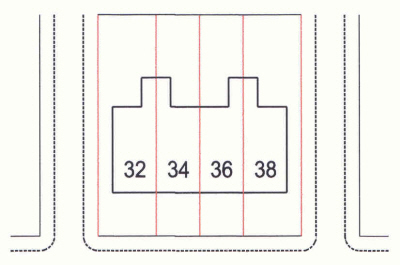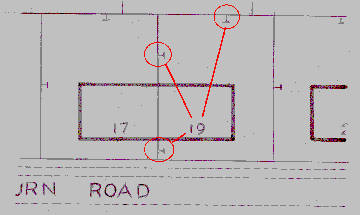Fence boundaries https://www.gov.uk/your-property-boundaries
There’s no law about who owns the boundaries around your property, eg which side of the fence, walls or hedges you’re responsible for. Check your deeds to find out if there are any boundary agreements. If nothing’s been agreed you can set up an agreement with your neighbours.
上面是政府的说法,一般在房产的资料(deed)上应该有说明(买房时候通过律师让对方提供deed的copy),如果没有说明那就和邻居商量解决。
---------------------------------------------------------------
Fence ownership: Who owns which fence? Is it true that every house owns the fence on its left side, as you look at it from the street?
http://www.boundary-problems.co.uk/boundary-problems/fences.html
There is no general rule about whether you own the fence on the left or the fence on the right of your property. The truth of the matter is this: it is the vendor who breaks up the land into smaller parcels before selling each parcel individually who assigns responsibility for the boundaries of the new land parcels that he creates. If he remembers to do so, then he will identify in the conveyance deed (or the transfer deed) the boundaries for which the purchaser is responsible.

Consider the picture above. It shows four houses, numbers 32, 34, 36, 38. Notice that, between them, they have five flank fences (shown in red). One of these four houses, therefore, must be responsible for both its flank boundaries.
[ul]
- This might mean that all of the houses are responsible for the boundary on their left and one of them is also responsible for the fence on its right;
-
or it might mean that they are all responsible for the fence on their right whilst one of them is also responsible for the fence on its left; -
but it doesn't tell us which house is responsible for the boundaries on both sides;
[/ul]
And who owns the rear boundaries? Numbers 32 to 38, or the houses in the parallel street behind?
The conveyance deed (or the transfer deed) may express in words the boundaries for which the owner of the property is responsible. If it does not then the conveyance (or the transfer) plan may employ the convention of applying a T-mark to those boundaries for which responsibility rests with the owner of the property (as in the diagram at right). If responsibility for the boundary is shared (for example, in the case of a “party fence wall”) then an H-mark (effectively two T-marks mirrored on the boundary line) is the conventional symbol that is used.

If the deeds are silent on the question of responsibility for the boundary then you may have to work on the basis of the information given in the Seller’s Property Information Form by the vendor at the time you bought your property.
It is sometimes possible to infer who is responsible for a fence by establishing the pattern of fence ownership along the same side of the street.
-----------------------------------------
How can I find out who owns a boundary fence?
http://www.inbrief.co.uk/neighbour-disputes/ownership-of-fences.htm
If you are unsure who owns a boundary fence you should first look at your title deeds.
The plan attached to your title deeds will show where the boundaries to your property lie. The red line on a title plan shows the position of the boundaries. On each side of the boundary line “T”s may be marked, although this is not always the case. “T”s indicate who owns the boundaries. If the “T” is situated on your property then you own the boundary in question. If it is situated on your neighbour’s property then they own the boundary in question. If there is an “H” mark, which straddles the boundary (effectively a “T” on each side of the boundary) then the boundary is jointly owned by you and your neighbour. Where this is the case the boundary is known as a “party” boundary.
If you have a mortgage on your property your deeds will be held with your mortgage lender and they will normally be prepared to release them to a solicitor upon the solicitor providing an undertaking to return them once he or she has finished looking at them. Normally mortgage lenders charge an administrative fee for releasing title deeds.
If your property is registered with the Land Registry, as most properties are these days, you could obtain “office copies” from the Land Registry. These may show who owns the boundaries to your property. The Land Registry may also hold a copy of your title deeds, although this is fairly uncommon – if they do this will be evident from the office copies. The Land Registry charge a fee for providing office copies and for providing copies of any other documents they hold copies of.
If your neighbour’s property is registered with the Land Registry you can also obtain a copy of the office copies relating to their property together with copies of any documents held by the Land Registry referred to in the office copies.
However, Land Registry office copies do not always show ownership of boundary features and if such information is not contained in the title deeds the office copies will not contain such information.
Deeds often contain covenants setting out who is responsible for maintaining a boundary feature such as a fence. However, such covenants do not necessarily confer ownership of the boundary feature on the person who is responsible for maintaining it.
You should also be aware that boundary features change from time to time and therefore, deeds and office copies are not conclusive as to ownership of boundary features. For example, the original fence may have been replaced by the neighbour.
Maintenance of the fence
If the ownership of the fence is not clear from the title deeds or office copies the party who has maintained the fence may be deemed to be the owner of it.
If the fence has been jointly maintained or has not been maintained by either party the fence may be regarded as a “party” fence (i.e. jointly owned by the parties).
If you want to try and establish who maintained the fence before you acquired the property then the information provided by the vendor when you purchased your property contained in the Seller’s Property Information Form may provide some assistance.
Common misconceptions
It is a common misconception that the manner in which a fence is constructed indicated who owns it. For example, it is commonly believed that the fact that the fence posts are located in one person’s garden indicates that they own the fence. However, whilst it is customary to construct a fence in such manner the position of the fence posts do not confirm who owns the fence.
It is also a common misconception that a person owns the boundary on the left hand side of their property, as you look at it from the street. This is not necessarily the case.
What rights, if any, do I have in relation to my neighbour’s fence?
If the boundary fence is owned by your neighbour you should not paint your side of the fence or attach nails to it unless you have their permission to do so. If you do not have their permission such acts will amount to criminal damage. Similarly, you should not hang things on their fence or use it to support your plants as such acts will amount to a trespass.
If you are unsure as to who owns the fence you should discuss matters of maintenance and the like with your neighbour before carrying out any such work yourself.
Can I force my neighbour to maintain their fence?
Some times deeds contain a provision (known as a “covenant”) requiring the owner of a boundary feature to maintain it, although this is fairly uncommon. If no such provision is contained in the deeds then there is no legal responsibility on the owner of the boundary feature to keep it in good repair. However, the owner of the boundary feature may be liable for any damage resulting from a boundary feature that falls into disrepair.